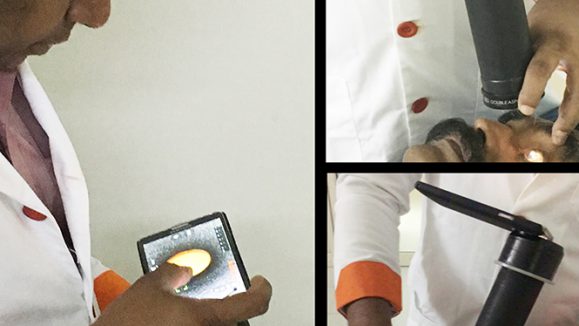Held at the joint EURETINA-ESCRS 2018 Congress in Vienna, Austria, the Ophthalmology Innovation Summit (OIS) discussed the latest developments in a variety of retina-related topics. The Summit was chaired by Dr. Emmett Cunningham Jr. (USA) and Prof. Dr. Sebastian Wolf (Switzerland).
Protecting ideas with patents
For aspiring inventors, Dr. Cunningham gave an interesting presentation on “Helpful Tips for Aspiring Entrepreneurs – A Venture Capital Perspective”. Here, he explained how ideas can be protected and emphasized the importance of filing before the idea is published or presented, noting that prior art is no longer patentable. He also stressed the importance of choosing the right advisers, and explained what it takes to bring tools, devices and drugs to market, among other things.
“You have to protect the intellectual property. That means you have to file with a patent office. In some countries, writing it all down in a notebook is enough to set a precedent, but not all,” said Dr. Cunningham.
“Also, if you talk about something in public before you file, you can no longer file. If you talk about something you hope to patent in a scientific meeting like this, and the patent office can be shown you did that, then you cannot file that patent,” he warned. “You need to file before you present.”
Screening newborns with AI
There was also a fascinating presentation on artificial intelligence (AI), prepared by Dr. Jochen Kumm (CEO and founder of Healio) and Prof. Dr. Darius M. Moshfeghi (from Stanford University Medical Center). Here, they discussed using deep learning to screen all healthy newborn babies for eye diseases to prevent blindness. In this case, using AI is attractive because AI has business liability and not malpractice liability (in the case of physicians), it is scalable and reproducible, and it minimizes marginal costs.
“Preventing blindness in babies has a large societal impact,” said Prof. Dr. Moshfeghi. “We have a database of over half a million images right now – the only database in the western world, because nobody else is actively screening. The AI we developed has sensitivity between 93 and 98 percent.” “Initially, we will be screening the images to determine whether they are normal or abnormal,” he added. “After FDA approval, we will be screening for specific diseases.”
New molecule to treat uveitis
In his presentation, Dr. Franz Obermayr, CEO of Panoptes Pharma (Austria), talked about the immune modulator PP-001. He explained that it was a unique anti-inflammatory novel molecule, with differentiating mode-of-action, and it can be used to treat non-infectious uveitis (intravitreal PaniJect) and dry eye disease (nano carrier eye drop PaniDrop). He stated that PaniJect can be a replacement for steroids and other therapies.
“Uveitis is a borderline orphan disease. Close to half a million patients in the USA are affected by non-infectious uveitis, and it’s one of the leading causes of blindness. And these people go blind (or are in danger of going blind) within three years. We are talking about 20 to 30 percent, despite all the treatments administered,” said Dr. Obermayr, adding that the current treatment is dominated by steroids.
The next generation of diagnosis
An interesting presentation by Dr. Carlos Ciller, co-founder and CEO of RetinAI (Switzerland), discussed how technology will reshape the world of eye care. Here, he talked about improving workflows in diagnosis, access and integration, and enabling disruptive hardware. In diagnosis, he spoke about automatic biomarker detection for a multitude of eye diseases affecting the retina. Furthermore, Dr. Ciller talked about low-cost and smartphone-based integrated solutions, enabling remote access. He discussed next-generation devices that will provide low-cost but high-end medical hardware.
“Sometimes, eye diseases don’t manifest, they are already there. There are chronic conditions that cause irreversible damage if left untreated. And in cases we see all over the world, the diseases are not treated on time. That’s why eye disease screening is important,” said Dr. Ciller.
“AI is changing the way we use images and information to accelerate the way we diagnose. We also need to educate the patients on how AI is going to help support the process, and educate clinicians that AI is going to empower them, not replace them,” explained Dr. Ciller.
Non-viral gene therapy to treat ocular disease
Dr. Ronald Buggage from Eyevensys (Paris, France), presented on innovative non-viral gene therapies for the treatment of ocular diseases. He emphasized the need for new treatment approaches in retinal diseases, especially intravitreal injections, ocular implants, viral gene therapy, and systemic administrations. He then talked about the Eyevensys technology that provides an innovative drug delivery platform that turns the eye into a biofactory.
“Most of the approaches we have for delivering drugs to the back of the eye, although they may have resulted in commercially interesting treatments, have limitations,” said Dr. Buggage.
“For example, with injections, you can inject anything in the eye, but the need to repeat those injections at intervals at high frequency has caused this commercially successful treatment approach to become a burden to both patients and the hospital system,” explained Dr. Buggage.
“On the other hand, ocular implants do away with the need for frequent injections, but most of these implants only contain corticosteroids. So, what we end up doing with these types of treatments is trading off the management of the initial disease with the problem of managing the systemic complications of corticosteroids. We have to use a very high level of systemic treatment,” shared Dr. Buggage.
“For now, gene therapy is limited to a small group of patients with inherited retinal diseases. We are just beginning to realize the potential of gene therapy, but it has to be administered with an invasive procedure, that is often not extended to the whole retina,” he said.
“So, the ideal treatment strategy would be to take the good points from the commercially successful treatments (like injecting drugs and sustained ocular delivery) and using implants with no side effects, and then having these proteins that you would be producing in the eye, be replicated in the disease pathogenesis. That ideal treatment is what we are looking to develop,” Dr. Buggage explained.
Editor’s Note: The Joint EURETINA-ESCRS 2018 Congress was held in Vienna, Austria, on September 20-26, 2018. Reporting for this story also took place at EURETINA-ESCRS 2018.



